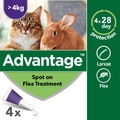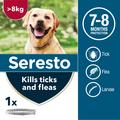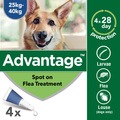Fleas and ticks are two of the most common parasites that can infest cats and dogs. These tiny insects feed on the blood of your pet, and if left untreated, can cause a host of health problems, ranging from mild irritation to life-threatening diseases.
Fortunately, there are several things you can do to prevent and treat flea and tick infestations in your furry friend. In this blog post, we’ll provide you with some essential tips for keeping your cat or dog free from these pesky pests.
Check your pet regularly for fleas and ticks
The best way to prevent a flea or tick infestation is to check your pet regularly for signs of these parasites. Use a flea comb to brush through your pet's coat and look for any signs of fleas or ticks. You should also check for any bumps or sores on your pet's skin, as these can be signs of flea or tick bites.
Use flea and tick preventives
One of the most effective ways to prevent flea and tick infestations is to use flea and tick preventives. There are several types of preventives available, including topical treatments, collars, and oral medications.
Topical treatments are applied directly to your pet's skin and are designed to kill fleas and ticks on contact. Collars, on the other hand, release a continuous dose of insecticide that repels fleas and ticks. Oral medications are taken by your pet and work by killing fleas and ticks from the inside out.
It's important to consult with your veterinarian before choosing a flea and tick preventive, as some preventives may not be suitable for all pets. Please find our selection of preventives here.
Keep your home clean
Fleas and ticks can easily infest your home, so it's important to keep your home clean and free from debris. Vacuum your carpets and furniture regularly, and wash your pet's bedding in hot water to kill any fleas or ticks that may be hiding in them.
You should also keep your yard clean and free from debris, as fleas and ticks can hide in tall grass and other vegetation. Regularly mow your lawn and remove any fallen leaves or other debris.
Use flea and tick-repellent sprays
Flea and tick-repellent sprays can be used in your home and yard to repel these pests. Look for sprays that contain insecticides such as permethrin or pyrethrin, as these are effective at killing fleas and ticks.
When using these sprays, it's important to follow the instructions carefully, as some sprays may be harmful to pets or humans if used improperly. Please find our sprays here.
Bathe your pet regularly
Bathing your pet regularly can help to remove any fleas or ticks that may be hiding in your pet's fur. Use a pet-friendly shampoo that is designed to kill fleas and ticks, and be sure to rinse your pet thoroughly to remove any soap residue.
It's important to note that bathing your pet too often can dry out their skin, so be sure to consult with your veterinarian to determine how often you should bathe your pet.
Check your yard for fleas and ticks
Fleas and ticks can infest your yard, so it's important to check your yard regularly for signs of these pests. Look for areas of your yard that may be shaded or damp, as these are common areas where fleas and ticks like to hide.
You can also use a flea and tick yard spray to treat your yard and prevent infestations. These sprays are designed to kill fleas and ticks on contact and can be applied to your yard using a hose or sprayer.
Keep your pet away from wildlife
Wild animals such as raccoons, squirrels, and opossums can carry fleas and ticks, so it's important to keep your pet away from them. If you live in an area with a lot of wildlife, consider keeping your pet indoors or on a leash when outside.
You should also avoid leaving pet food outside, as this can attract wild animals to your yard.
Be vigilant during flea and tick season
Flea and tick season can vary depending on where you live, but generally occurs during the warmer months. During flea and tick season, it's important to be extra vigilant in checking your pet for signs of these pests.
You may also want to consider using additional preventive measures during this time, such as a flea and tick collar or topical treatment.
Know the signs of flea and tick infestations
Knowing the signs of flea and tick infestations can help you catch these pests early and prevent them from causing serious health problems for your pet. Signs of flea infestations include:
-
Excessive scratching or biting at the skin
-
Red, irritated skin or bumps on the skin
-
Black or dark brown flecks in your pet's fur (which are flea feces)
Signs of tick infestations include:
-
Swollen, red, or irritated skin at the site of the tick bite
-
A tick visible on your pet's skin
If you notice any of these signs, it's important to consult with your veterinarian as soon as possible.
Treat your home and yard for fleas and ticks
If your pet has a flea or tick infestation, it's important to treat your home and yard as well. Fleas and ticks can lay eggs in your home and yard, leading to a never-ending cycle of infestations.
Use a flea and tick spray or fogger to treat your home, and consider hiring a professional pest control service to treat your yard. Be sure to follow the instructions carefully, and keep your pet away from treated areas until it's safe for them to return.
In conclusion, flea and tick infestations can be a serious problem for cats and dogs, but with the right preventive measures and treatment, you can keep your pet free from these pests. Be sure to check your pet regularly for signs of fleas and ticks, use preventive measures, keep your home and yard clean, and be vigilant during flea and tick season. And if you do notice signs of an infestation, don't hesitate to consult with your veterinarian for advice on how to treat the problem.
Please find our other blogs on fleas and ticks here.
Written by: Lee








